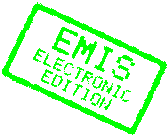Enumeration of symmetry classes of alternating sign matrices and characters of classical groups
Soichi Okada
Nagoya University Graduate School of Mathematics Furo-cho, Chikusa-ku Nagoya 464-8602 Japan Furo-cho, Chikusa-ku Nagoya 464-8602 Japan
DOI: 10.1007/s10801-006-6028-3
Abstract
An alternating sign matrix is a square matrix with entries 1, 0 and - 1 such that the sum of the entries in each row and each column is equal to 1 and the nonzero entries alternate in sign along each row and each column. To some of the symmetry classes of alternating sign matrices and their variations, G. Kuperberg associate square ice models with appropriate boundary conditions, and give determinant and Pfaffian formulae for the partition functions. In this paper, we utilize several determinant and Pfaffian identities to evaluate Kuperberg's determinants and Pfaffians, and express the round partition functions in terms of irreducible characters of classical groups. In particular, we settle a conjecture on the number of vertically and horizontally symmetric alternating sign matrices (VHSASMs).
Pages: 43–69
Keywords: keywords alternating sign matrix; classical group character; determinant; Pfaffian
Full Text: PDF
References
1. C.W. Borchardt, “Bestimmung der symmetrischen Verbindungen vermittelst ihrer erzeugenden Funktion,” J. Reine Angew. Math. 53 (1855), 193-198.
2. D.M. Bressoud, Proofs and Confirmations, Mathematical Association of America, Washington, DC, 1999.
3. A.L. Cauchy, “Mémoire sur les fonctions alternées et sur les sommes alternées,” Exercices Anal. et Phys. Math. 2 (1841), 151-159.
4. M. Ishikawa, H. Kawamuko, and S. Okada, “A Pfaffian-Hafnian analogue of Borchardts' identity,” Electron. J. Combin. 12 (2005), N 9 (arXiv:math.CO/0408364).
5. M. Ishikawa, S. Okada, H. Tagawa, and J. Zeng, “Generalizations of Cauchy's determinant and Schur's Pfaffian,” to appear in Adv. Appl. Math., arXiv:math.CO/0411280.
6. G. Kuperberg, “Another proof of the alternating-sign matrix conjecture,” Internat. Math. Res. Notices (1996), 139-150 (arXiv:math.CO/9712207).
7. G. Kuperberg, “Symmetry classes of alternating-sign matrices under one roof,” Ann. Math. 156 (2002), 835-866 (arXiv:math.CO/0008184).
8. D. Laksov, A. Lascoux, and A. Thorup, “On Giambelli's theorem on complete correlations,” Acta Math. 162 (1989), 143-199.
9. W.H. Mills, D.P. Robbins and H. Rumsey, Jr., “Alternating sign matrices and descending plane partitions,” J. Combin. Theory Ser. A 34 (1983), 340-359.
10. S. Okada, “Application of minor summation formulas to rectangular-shaped representations of classical groups,” J. Algebra 205 (1998), 337-367.
11. A.V. Razumov and Y.G. Stroganov, “On refined enumerations of some symmetry classes of ASMs,” Theoret. and Math. Phys. 141 (2004), 1609-1630 (arXiv:math-ph/0312071).
12. D.P. Robbins, “Symmetry classes of alternating sign matrices,” arXiv:math.CO/0008045.
13. D.P. Robbins and H. Rumsey, Jr., “Determinants and alternating sign matrices,” Adv. Math. 62 (1986), 169-184.
14. I. Schur, “ \ddot Uber die Darstellung der symmetrischen und der alternirenden Gruppe durch gebrochene lineare Substitututionen,” J. Reine Angew. Math. 139 (1911), 155-250.
15. J.R. Stembridge, “Non-intersecting paths, Pfaffians and plane partitions,” Adv. Math. 83 (1990), 96-131.
16. Y.G. Stroganov, “A new way to deal with Izergin-Korepin determinant at root of unity,” arXiv:mathph/0204042.
17. D. Zeilberger, “Proof of the alternating sign matrix conjecture,” Electron J. Combin. 3(2) (1996), R 13 (arXiv:math.CO/9407211).
2. D.M. Bressoud, Proofs and Confirmations, Mathematical Association of America, Washington, DC, 1999.
3. A.L. Cauchy, “Mémoire sur les fonctions alternées et sur les sommes alternées,” Exercices Anal. et Phys. Math. 2 (1841), 151-159.
4. M. Ishikawa, H. Kawamuko, and S. Okada, “A Pfaffian-Hafnian analogue of Borchardts' identity,” Electron. J. Combin. 12 (2005), N 9 (arXiv:math.CO/0408364).
5. M. Ishikawa, S. Okada, H. Tagawa, and J. Zeng, “Generalizations of Cauchy's determinant and Schur's Pfaffian,” to appear in Adv. Appl. Math., arXiv:math.CO/0411280.
6. G. Kuperberg, “Another proof of the alternating-sign matrix conjecture,” Internat. Math. Res. Notices (1996), 139-150 (arXiv:math.CO/9712207).
7. G. Kuperberg, “Symmetry classes of alternating-sign matrices under one roof,” Ann. Math. 156 (2002), 835-866 (arXiv:math.CO/0008184).
8. D. Laksov, A. Lascoux, and A. Thorup, “On Giambelli's theorem on complete correlations,” Acta Math. 162 (1989), 143-199.
9. W.H. Mills, D.P. Robbins and H. Rumsey, Jr., “Alternating sign matrices and descending plane partitions,” J. Combin. Theory Ser. A 34 (1983), 340-359.
10. S. Okada, “Application of minor summation formulas to rectangular-shaped representations of classical groups,” J. Algebra 205 (1998), 337-367.
11. A.V. Razumov and Y.G. Stroganov, “On refined enumerations of some symmetry classes of ASMs,” Theoret. and Math. Phys. 141 (2004), 1609-1630 (arXiv:math-ph/0312071).
12. D.P. Robbins, “Symmetry classes of alternating sign matrices,” arXiv:math.CO/0008045.
13. D.P. Robbins and H. Rumsey, Jr., “Determinants and alternating sign matrices,” Adv. Math. 62 (1986), 169-184.
14. I. Schur, “ \ddot Uber die Darstellung der symmetrischen und der alternirenden Gruppe durch gebrochene lineare Substitututionen,” J. Reine Angew. Math. 139 (1911), 155-250.
15. J.R. Stembridge, “Non-intersecting paths, Pfaffians and plane partitions,” Adv. Math. 83 (1990), 96-131.
16. Y.G. Stroganov, “A new way to deal with Izergin-Korepin determinant at root of unity,” arXiv:mathph/0204042.
17. D. Zeilberger, “Proof of the alternating sign matrix conjecture,” Electron J. Combin. 3(2) (1996), R 13 (arXiv:math.CO/9407211).
